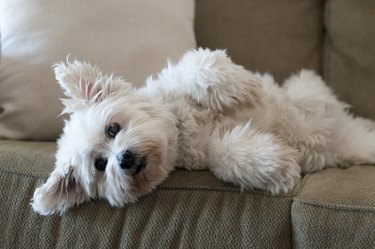
If you have a dog, you've likely seen it before: that furry mohawk that appears down the length of her back from time to time. Sometimes accompanied by a bark, other times paired with an investigative twitch of the nose, the stripe is generally a sign that something unfamiliar is currently going down. Most commonly referred to as "raised hackles," the stripe or patches of hair that stand on end when some dogs become excited are usually seen as a sign of aggression. But is that what it really means? And what causes a dog's hair to raise like that?
What does it mean?
Video of the Day
Raised hackles on a dog can happen for many reasons. Some dogs raise theirs when there's a knock at the door; others do it when they see another dog. Maybe he's picked up a strange smell on his nightly walk. All of these instances suggest alertness or protection, which could be the case for some.
Video of the Day
Regardless of the reason, all dogs raise their hackles with one objective: to appear larger. Porcupines do the same thing, puffing up their quills to ward off potentially harmful visitors. When faced with an unfamiliar situation, almost anyone would feel a little safer with some size on their side, and dogs are no different. When you see raised hackles on a dog, it might not mean "I'm going to attack you," but, more accurately, "I'm not sure what's about to happen, but I am prepared for anything, either way."
Raised hackles during playtime
Some dogs, however, raise their hair when they are in the middle of play, which is usually not associated with aggressive tendencies. When your dog's hackles are raised during playtime, it's usually because she's simply too excited. This is usually not a cause for concern, but if you know that your dog's anxiety can lead to aggressive behavior, you should take measures to ensure that any dogs involved stay safe.
What causes it?
We know when it happens, but why does it happen? Or, more specifically, how? A recent article on Pet Helpful breaks down the science behind that stiff-straight hairdo. They explain that the hairs that run along a dog's backbone, usually from his neck to right around the base of his tail, is equipped with a function known as piloerection. As the name suggests, this causes the hair (pilo) to stand upright (erect.)
Dogs have muscles in their skin that are connected to their hair follicles, which causes the hair to stand on end. This is an involuntary function that happens when a dog's senses become triggered, usually by something that provokes fear or danger. Every dog is equipped with this evolutionary function, although it may be harder to see on certain breeds, like curly or long-haired types. In these cases, raised hackles usually appear around the shoulders, where the hair is typically shorter.
Is it aggression?
That answer depends on your dog and the specific circumstances that cause her hair to raise. Because the raised hackles are an involuntary response of your dog's nervous system, it isn't necessarily aggression that you're witnessing. More accurately, when your dog's hair is standing on end, it simply suggests that she is surprised, and just isn't quite sure what to make of the situation.
Sometimes, however, it can be a sign that your dog is giving off signals to back off, or else. According to Dogster, aggressive signaling can be spotted when raised hackles are paired with other physical traits. Every dog has their own brand of warning, but common signs of aggression include laid-back ears, visible teeth, and rigid posture in the body. If you've witnessed these behaviors in combination with raised hackles, note which situations these traits tend to appear in, and exercise caution by either preventing exposure to them or removing your dog from them.